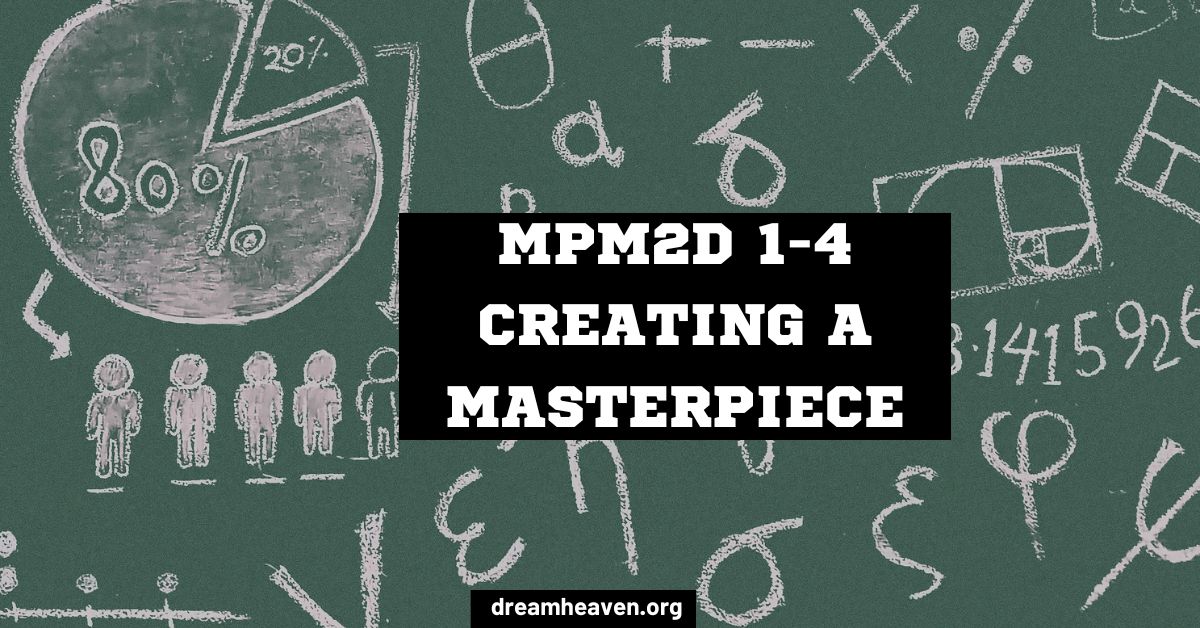Mathematics can often feel abstract, but in the context of “MPM2D 1-4 creating a masterpiece,” students get a chance to see math come alive through artistic expression. This lesson in the Grade 10 Academic Mathematics course (MPM2D) explores how geometry, algebra, and transformations can merge with creativity to produce a visually stunning masterpiece.
What Does “MPM2D 1-4 Creating a Masterpiece” Entail?
In “MPMD 1-4 creating a masterpiece,” students use mathematical principles like linear equations, coordinate geometry, and transformations to design unique artistic creations. This lesson goes beyond rote calculations, encouraging learners to appreciate the beauty of mathematics.
Key Mathematical Concepts in the Lesson
Linear Relations
A major focus in “MPM2D 1-4 creating a masterpiece” is understanding and plotting linear equations. These lines serve as the building blocks for patterns and designs.
Transformations
Translations: Moving shapes without changing their form.
Reflections: Creating symmetry by mirroring elements.
Rotations: Adding movement and dynamism to the design.
Symmetry
Symmetry plays a crucial role in “MPM2D 1-4 creating a masterpiece.” Whether it’s about reflecting shapes across the axes or using rotational symmetry, this concept ensures balance and visual appeal.
How to Approach “MPM2D 1-4 Creating a Masterpiece”
Set Up a Coordinate Plane
The first step in “MPM2D 1-4 creating a masterpiece” is to draw a Cartesian plane. This is where all plotting and transformations take place.
Choose Your Equations
Select linear equations to form lines and shapes. For example:
y = 2x + 1
y = -x + 4
These equations create intersecting lines that can be used to form polygons or other patterns.
Add Transformations
Apply translations, reflections, and rotations to modify your design. These transformations allow for creativity while keeping mathematical precision.
Explore Symmetry
Symmetry ensures that the design in “MPMD 1-4 creating a masterpiece” looks balanced and professional. Reflect shapes or rotate them around a central point for a stunning visual effect.
Finalize Your Design
Color-code sections, label coordinates, and ensure that the entire design adheres to mathematical rules.
Real-Life Applications of “MPM2D 1-4 Creating a Masterpiece”
Graphic Design: Concepts from “MPMD 1-4 creating a masterpiece” are useful in logo design and digital art.
Architecture: Geometric patterns derived from math help in designing buildings.
Game Development: Coordinate geometry is essential in creating visual effects and landscapes.
Engineering: Transformations and symmetry are critical in designing functional and aesthetic structures.
Tips for Success in “MPMD 1-4 Creating a Masterpiece”
Plan Your Design: Visualize your masterpiece before plotting it on the graph.
Use Technology: Tools like graphing calculators or software like Desmos can simplify the process.
Be Creative: Incorporate personal flair while adhering to mathematical rules.
Check Symmetry: Ensure that all reflective and rotational symmetries align perfectly.
Why “MPMD 1-4 Creating a Masterpiece” Is Important
This lesson highlights the connection between math and art, proving that mathematics is not just about numbers but also about creating beauty. Students develop a deeper appreciation for math and its practical applications while nurturing their creativity.
Conclusion
“MPMD 1-4 creating masterpiece” is a perfect blend of logic and creativity, allowing students to explore mathematics in a fresh and engaging way. By combining linear equations, transformations, and symmetry, this lesson transforms abstract math concepts into tangible works of art. Whether you’re an aspiring artist or a math enthusiast, this activity demonstrates the limitless possibilities of merging two seemingly different fields.
FAQs
1. What is the goal of “MPMD 1-4 creating masterpiece”?
The goal is to help students use mathematical concepts like linear equations and transformations to create visually appealing designs.
2. How does symmetry enhance the designs?
Symmetry ensures balance and aesthetic appeal, making the designs more visually engaging.
3. Can technology be used in “MPMD 1-4 creating masterpiece”?
Yes, graphing calculators and software like Desmos can help plot equations and visualize transformations.
4. What skills are developed through this lesson?
Students develop problem-solving, artistic creativity, and an understanding of mathematical applications.
5. Is “MPMD 1-4 creating masterpiece” suitable for all skill levels?
Yes, the lesson is adaptable for different levels, allowing all students to engage with math creatively.

